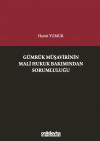The Protection Of The Economic And Social Rights Under European Convention Human Right Through The Indivisibility Of Human Rights And Interpretation Of The Convention
Hamit Yumuk
Scholars and the European Court of Human Rights (the Court) accept that human rights are indivisible, interdependent, and interrelated. However, the extent to which the indivisibility of the human rights is activated with the help of the interpretation methods deployed by the Court, and thus the extent to which social, economic and cultural rights are guaranteed through the interpretation, has not yet been clearly identified. Therefore, the main of the book is to identify whether the interpretation methods deployed by the Court serve to realize the indivisibility of the human rights under the Convention and if so, to what extent social economic rights are protected effectively. The book consists of four chapters. The first chapter contains explanation of the research aim and objectives, explains research structure and also constitutes a literature review. Second chapter addresses the concepts of the classification of rights as civil and political and social, economic and cultural, identifies the indivisibility of human rights and the justiciability of social and economic rights. Chapter third explains the interpretation methods deployed by the Court. The final chapter of the book examines the case-law of the Court.(ARKA KAPAKTAN)
Table of Contents
CHAPTER 1
Structure and Literature Review
1.1. Aim of the study
1.2. Research methodology
1.3. Structure of the study
1.4. Literature review
CHAPTER 2
Basic Concept of Human Rights Discourse
2.1. Human rights and categorisation of the human rights
2.2. The doctrine of indivisibility
2.3. The justiciability of social and economic rights and obligations of states
CHAPTER 3
Interpretation of the European Convention on Human Rights
3.1. Introduction
3.2. Judicial self-restraint principles of the interpretation of the Convention
3.2.1. Originalism
3.2.1.1. Intentionalism
3.2.1.2. Textualism
3.2.2. Doctrine of margin of appreciation
3.2.3. The doctrine of fourth instance
3.3. Judicial activist principles of interpretation of the Conventions
3.3.1. The Doctrine of an autonomous concept
3.3.2. The living instrument doctrine or evolutive Interpretation
3.3.3. The doctrine of effectiveness or innovative interpretations
CHAPTER 4
Analysis of the Case Law
4.1. Limiting the protection of social and economic rights by taking judicial self-restraint principles as the interpretation of the Convention
4.2. The protection of Social and Economic Rights by taking judicial activist principles of interpretation of the Conventions
Conclusion
Bibliography




